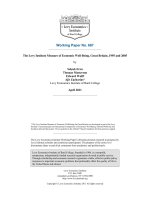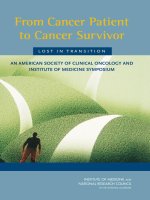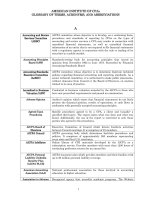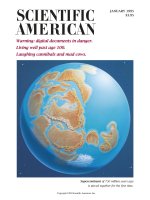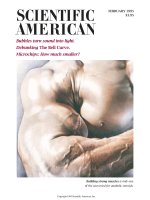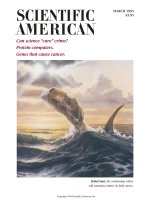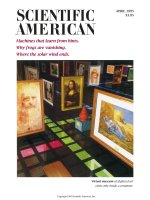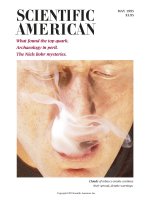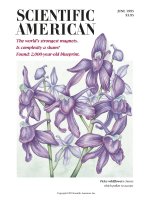Api tr 402 1995 (american petroleum institute)
Bạn đang xem bản rút gọn của tài liệu. Xem và tải ngay bản đầy đủ của tài liệu tại đây (1.76 MB, 75 trang )
~~
A P I TR*402
9 5 U 0 7 3 2 2 7 0 0 5 5 4 6 4 8 O96
II
II
American
Petroleum
Institute
Health and Environmental
Sciences Department
Tertiary-Amyl Methyl Ether
(TAME)
FEBRUARY 1995
TOXICOLOGY REPORT NUMBER 402
CAIS ABSTRACT NO. 41-5415
Copyright American Petroleum Institute
Provided by IHS under license with API
No reproduction or networking permitted without license from IHS
Not for Resale
--`,,-`-`,,`,,`,`,,`---
Toxicity to the Freshwater Alga,
Selenastrurn capricornuturn
A P I T R * 4 0 2 95 I0’732290 0 5 5 4 6 4 9 T 2 2 I
EnwmwuntafPartnership
One of the most significant long-term trends affecting the future vitality of the petroleum industry is the
public’s concerns about the environment. Recognizing this trend, API member companies have developed a
positive, forward-looking strategy called STEP: Strategies for Today’s Environmental Partnership. This
program aims to address public concerns by improving our industry’s environmental, health and safety
performance; documenting performance improvements; and communicating them to the public. The
foundation of STEP is the API Environmental Mission and Guiding Environmental Principles.
API ENVIRONMENTAL MISSION AND GUIDING ENVIRONMENTALPRINCIPLES
The members of the American Petroleum Institute are dedicated to continuous efforts to improve the
compatibility of our operations with the environment while economically developing energy resources and
supplying high quality products and services to consumers. The members recognize the importance of
efficiently meeting society’s needs and our responsibility to work with the public, the government, and others
to develop and to use natural resources in an environmentally sound manner while protecting the health and
safety of our employees and the public. To meet these responsibilities, API members pledge to manage our
businesses according to these principles:
recognize and to respond to community concerns about our raw materials, products and
operations.
O To
O
To operate our plants and facilities, and to handle our raw materials and products in a manner that
protects the environment, and the safety and health of our employees and the public.
O To make safety, health and environmental considerations a priority in our planning, and our
O To advise promptly, appropriate officials, employees, customers and the public of information on
significant industry-related safety, health and environmental hazards, and to recommend
protective measures.
9 To counsel customers, transporters and others in the safe use, transportationand disposal of our
raw materials, products and waste materials.
O
To economically develop and produce natural resources and to conserve those resources by
using energy efficiently.
O
To extend knowledge by conducting or supporting research on the safety, health and
environmental effects of our raw materials, products, processes and waste materials.
9 To commit to reduce overall emission and waste generation.
9 To work with others to resolve problems created by handling and disposal of hazardous
substances from our operations.
O To participate with government and others in creating responsible laws, regulationsand standards
to safeguard the community, workplace and environment.
+ To promote these principles and practices by sharing experiences and offering assistance to
others who produce, handle, use, transport or dispose of similar raw materials, petroleum products
and wastes.
Copyright American Petroleum Institute
Provided by IHS under license with API
No reproduction or networking permitted without license from IHS
Not for Resale
--`,,-`-`,,`,,`,`,,`---
development of new products and processes.
A P I TRx402 95
0 7 3 2 2 9 0 0554650 744 M
FOREWORD
API PUBLICATIONS NECESSARILY ADDRESS PROBLEMS OF A GENERAL
NATURE. WITH RESPECT TO PARTICULAR CIRCUMSTANCES, LOCAL,
STATE, AND FEDERAL LAWS AND REGULATIONS SHOULD BE
REVIEWED.
API IS NOT UNDERTAKING TO MEET THE DUTIES OF EMPLOYERS,
MANUFACTURERS, OR SUPPLIERS TO WARN AND PROPERLY TRAIN
AND EQUIP THEIR EMPLOYEES, AND OTHERS EXPOSED, CONCERNING
HEALTH AND SAFETY RISKS AND PRECAUTIONS, NOR UNDERTAKING
THEIR OBLIGATIONS UNDER LOCAL, STATE, OR FEDERAL LAWS.
--`,,-`-`,,`,,`,`,,`---
NOTHING CONTAINED IN ANY API PUBLICATION IS TO BE CONSTRUED
AS GRANTING ANY RIGHT, BY IMPLICATION OR OTHERWISE, FOR THE
MANUFACTURE, SALE, OR USE OF ANY METHOD, APPARATUS, OR
PRODUCT COVERED BY LETTERS PATENT. NEITHER SHOULD ANYTHING CONTAINED IN THE PUBLICATION BE CONSTRUED AS INSURING
ANYONE AGAINST LIABILITY FOR INFRINGEMENT O F LETTERS
PATENT.
Copyright O 1995 American Petroleum Institute
Copyright American Petroleum Institute
Provided by IHS under license with API
No reproduction or networking permitted without license from IHS
Not for Resale
~~~~~
A P I TR*402 95
m
~
0732290 0 5 5 4 6 5 1 680
m
ACKNOWLEDGMENTS
THE FOLLOWING PEOPLE ARE RECOGNIZED FOR THEIR CONTRIBUTIONS OF TIME AND EXPERTISE DURING THIS STUDY AND IN THE
PREPARATION OF THIS REPORT:
API STAFF CONTACT
Richard Rhoden, Ph.D., Health and Environmental Sciences Department
MEMBERS OF THE AIRAJELS TOXICOLOGY
HEALTHEFFECTS WORKGROUP
Russell D. White, Ph.D., C h u i m n , Chevron Research & Technology, Inc.
Rudolph J. Breglia, Ph.D., BP America, Inc.
Charles R. Clark, Ph.D., Unocal
Wayne Daughtrey, Ph.D., Exxon Biomedical Sciences, Inc.
David Duncan, Texaco, Inc.
Francis J. Koscher, Ph.D., ARCO
Charles A. Lapin, Ph.D., ARCO
David C. Logan, M.D., Mobil Corporation
John H. Mitchell, M.D., Amoco Corporation
Susan A. Rodney, Ph.D., Texaco, Inc.
Ceinwen A. Schreiner, Ph.D., Stonybrook Laboratories
David R. Steup, Ph.D., Shell Oil Company
Michael S . Wells, Ph.D., Amoco Corporation
--`,,-`-`,,`,,`,`,,`---
Copyright American Petroleum Institute
Provided by IHS under license with API
No reproduction or networking permitted without license from IHS
Not for Resale
~
~~
API T R + 4 0 2 95
~~
0732290 0 5 5 4 6 5 2 517
American Petroleum institute
Health and Environmental Sciences Department
QUALITY ASSURANCE/GLP COMPLIANCE STATEMENT
Study Title: Tert-Amyl Methyl Ether (TAME) - Toxicity to the
Freshwater Alga, Sehnastrum cupricarutum
Testing Facility: Springborn Laboratories, Inc.
SLI Study Number:
12827.0692.6106.430
This study was reviewed by API Quality Assurance personnel under
the direction of API Management on the dates indicated below for
compliance with EPA (TSCA) Good Laboratory Practice (GLP)
regulations. These studies were conducted in accordance with EPA
GLP regulations, with the exceptions* listed below.
Copies of reports by API Quality Assurance personnel are
available upon written request to the Director of the Health and
Environmental Sciences Department of the American Petroleum
Institute or his designee.
Date(s) of
Inspection/Review
--`,,-`-`,,`,,`,`,,`---
8/28/92
Type of
Inspection
Protocol
Evaluation
Date of
Report to
Manaqement
8/28/92
12/2/93
Protocol Amendment
Review
12/2/93
4/27-28/94
Draft Report
Audit
4/29/94
Final Report
Acceptance
8/15/94
8/15/94
Christine Sedmith
Quality Assurance Coordinator
*Test article characterization, other than that received by the
manufacturer ( 9 8 . 8 % pure TAME) was not performed, storage
stability for this test article is not known, and the method of
fabrication is maintained with the test article supplier.
Copyright American Petroleum Institute
Provided by IHS under license with API
No reproduction or networking permitted without license from IHS
Not for Resale
~~~
API T R * 4 0 2 95
0732290 0554b53 453
Spring born Laboratories, Inc.
Environmental Sciences Division
790 Main Street o Wareham, Massachusetts 02571-1075
0
(508) 295-2550
0
Telex 4436041
0
Facsimile (508) 295-8107
AMENDMENT TO THE STUDY FINAL REPORT
Final Report Tttle:
-
Ted-Amyl Methyl Ester (TAME) Toxicity to the Freshwater Alga,
Selenastrum capricornutum
Amendment No. 1
Amendment Date: 12 August 1994
SU Study No. 12827.0692.6106.430
SLI Report No. 93-11-5065
Study Sponsor: American Petroleum Institute
Study Director: James
R. Hoberg
Final Report Modifications and/or Additions:
page2
-
In the third sentence, "maintenance of records" was changed to "maintenance
of these records"
page 12 -
In the second complete sentence, "vessel control" was changed to "control
vessel"
page 15 -
The statistical section was clarified to explain that EC values could not be
calculated at the 48-hour interval
page 18 -
Solubility and volatility information was added to the end of the first paragraph.
-
- -
page 27
--`,,-`-`,,`,,`,`,,`---
page 28 -
Reference to section 2.6 of the repod was added to the eighth sentence.
A column for nominal concentrations was added to Table 4.
Footnote "P' was added to the table.
The 96 hour cell density value for the B replicate of the 0.52 mg A.I./L treatment
level was corrected to read "9"
The 4Shour EClO, EC50 and EC90 results were removed from the table.
L E V E R S AN3 REPORTS SpngtMr? Laboratories inc ieners ano repons aie issued for lne exclusive use O' lhe ilierts io w i o i the!. are a:ziessec h;i q m a i Y S %- r t : - z i ' '
use o+the Springborr Laboratories I n i name IS permitlea excepl as eapressly autnorizeb in writ 19 Leners a m repons apc y o-,, 15 the S D ~ C I ' S Cmite. a b p'3cL?s 3' woies'eo ' F C ' P examined or surveyed ana are no1 necessarily indicative of the quaiil!es 01 8pparewy iaenlica or Slmi:ar maie*ia's ~ ~ O C J C Ior
S D-OC~S~FS
Tne ' 5t)i ,I,o' QE..npt)~- ;ab:.'a!:'
C T IC:
w#lhrespect to se*mes rendered shall be iirnited IO the amom1 of the consloera1,on paio for sbcn sewces ano no1 inc..tde z-! coTiseaLell ã az-aqts
Copyright American Petroleum Institute
Provided by IHS under license with API
No reproduction or networking permitted without license from IHS
Not for Resale
~~
A P I T R m 4 0 2 95
= 0732290
~~
0559654 3 ï T
=
Appendix il - The Certificate of Analysis for Lot No. 07905KZ was removed as this lot was
not used during testing.
Approval Signatures:
4
James R. Hoberg
Study Director
fl
r/z/91/
-
--`,,-`-`,,`,,`,`,,`---
Supervisor, Quality Assurance Unit
Copyright American Petroleum Institute
Provided by IHS under license with API
No reproduction or networking permitted without license from IHS
Not for Resale
Page 1 of 66
-
TERT-AMYL METHYL ETHER (TAME)
TOXICITY TO THE FRESHWATER ALGA,
Selenastrum capricornutum
GUIDEUNE REFERENCE NUMBER: 797-1050
Submitted to:
American Petroleum Institute
1220 L Street, Northwest
Washington, D.C. 20005
SLI Report #93-11-5065
S U Study #12827.0692.6106.430
Study Director: James R. Hoberg
Springborn Laboratories, Inc.
Environmental Sciences Division
790 Main Street
Wareham, Massachusetts 02571
12 August 1994
AMENDED FINAL REPORT
--`,,-`-`,,`,,`,`,,`---
Copyright American Petroleum Institute
Provided by IHS under license with API
No reproduction or networking permitted without license from IHS
Not for Resale
A P I T R t 4 0 2 95
0732290 0554b56 L b 2
=
Report No. 93-11-5065
Page 2 of 66
GOOD LABORATORY PRACTICES COMPLIANCE STATEMENT
The data and report prepared for "Ted-Amyl Methyl Ether (TAME)
- Toxicity To The
FreshwaterAlga, Selenasfrum capricornutum"were produced and compiled in accordance with
--`,,-`-`,,`,,`,`,,`---
all pertinent U.S. EPA Good Laboratory Practice Regulations (40 CFR, Part 792) with the following
exceptions: routine water screening analyses for pesticides, PCBs and metals are conducted
using standard U.S. EPA procedures by Lancaster Laboratories, Lancaster, PA. These data were
not collected in accordance with Good Laboratory Practice procedures (¡.e. no distinct protocol,
Study Director, etc.). Stability, characterization and verification of the test material identity and
maintenance of these records on the test material are the responsibility of the Study Sponsor.
At the termination of the testing program, all remaining test material will be sent to the Study
Sponsor. Archival of a sample of the test material is the responsibility of the Study Sponsor.
SPRINGBORN IABORATORIES, INC.
g a m e s R. Hoberg
Study Director
Springborn Laboratories, Inc.
Copyright American Petroleum Institute
Provided by IHS under license with API
No reproduction or networking permitted without license from IHS
Not for Resale
f
Dáte
~
~~
~
A P I TR8402 95
~
~~~
0 7 3 2 2 9 0 O554657 O T ï
Report No . 93-11-5065
Page 3 of 66
TABLE OF CONTENTS
PAGE
GOOD LABORATORY PRACTICES COMPUANCE STATEMENT
UST OF TABLES
................... 2
. . . . . . . . . .. . . . . . . . . . . . . . . . . . . . . . . . . . . . . . . . . . . . . . . . . . . .
5
USTOFFIGURES . . . . . . . . . . . . . . . . . . . . . . . . . . . . . . . . . . . . . . . . . . . . . . . . . . . . . . .
6
............................................................
7
.....................................................
9
SUMMARY
1.0 INTRODUCTION
2.0 MATERIALS AND METHODS . . . . . . . . . . . . . . . . . . . . . . . . . . . . . . . . . . . . . . . . . . .
2.1 Protocol . . . . . . . . . . . . . . . . . . . . . . . . . . . . . . . . . . . . . . . . . . . . . . . . . . . . . . . . .
2.2TestMaterial . . . . . . . . . . . . . . . . . . . . . . . . . . . . . . . . . . . . . . . . . . . . . . . . . . . . . .
2.3TestOrganism . . . . . . . . . . . . . . . . . . . . . . . . . . . . . . . . . . . . . . . . . . . . . . . . . . .
2.4 Test Dilution Water . . . . . . . . . . . . . . . . . . . . . . . . . . . . . . . . . . . . . . . . . . . . . . . .
2.5 Test Concentrations . . . . . . . . . . . . . . . . . . . . . . . . . . . . . . . . . . . . . . . . . . . . . . .
2.6 Preparation of Test Solutions . . . . . . . . . . . . . . . . . . . . . . . . . . . . . . . . . . . . . . . .
9
9
9
10
11
11
11
................................................
12
3.1TestInitiation . . . . . . . . . . . . . . . . . . . . . . . . . . . . . . . . . . . . . . . . . . . . . . . . . . . . 12
3.2 Test Monitoring . . . . . . . . . . . . . . . . . . . . . . . . . . . . . . . . . . . . . . . . . . . . . . . . . .
12
3.2.1 Algal Growth . . . . . . . . . . . . . . . . . . . . . . . . . . . . . . . . . . . . . . . . . . . . . .
12
3.2.2 Recovery . . . . . . . . . . . . . . . . . . . . . . . . . . . . . . . . . . . . . . . . . . . . . . . .
13
3.0 TEST PROCEDURES
3.2.3 Test Conditions . . . . . . . . . . . . . . . . . . . . . . . . . . . . . . . . . . . . . . . . . . .
3.2.4 Chemical Analysis . . . . . . . . . . . . . . . . . . . . . . . . . . . . . . . . . . . . . . . . . .
13
14
.............................................
14
5.1 Preliminary Testing . . . . . . . . . . . . . . . . . . . . . . . . . . . . . . . . . . . . . . . . . . . . . . . .
5.2 Definitive Testing . . . . . . . . . . . . . . . . . . . . . . . . . . . . . . . . . . . . . . . . . . . . . . . . .
..........................................
15
15
17
................................................
20
..................................
21
4.0 STATISTICAL ANALYSIS
5.0 RESULTS AND DISCUSSION
PROTOCOL DEVIATIONS
QUAUTY ASSURANCE UNIT STATEMENT
. . . . . . . . . . . . . . . . . . . . . . . . . . . . . . . . . . . . . . . . . . . . . . . . . . . . . . . . 22
TABLES
.............................................................
23
FIGURE
..............................................................
29
Springborn Laboratories. Inc.
Copyright American Petroleum Institute
Provided by IHS under license with API
No reproduction or networking permitted without license from IHS
Not for Resale
--`,,-`-`,,`,,`,`,,`---
REFERENCES
--`,,-`-`,,`,,`,`,,`---
.
Paqe 4 of 66
Report No 93-11-5065
SIGNATURES .AND APPROVAL
...........................................
.
7.0 APPENDIX II .CERTIFICATE OF ANALYSIS . . . . . . . . . . . . . . . . . . . . . . . . . . . . . . .
8.0 APPENDIX 111 .DILUTION WATER ANALYSIS . . . . . . . . . . . . . . . . . . . . . . . . . . . . .
9.0 APPENDIX IV .ANALYTICAL METHODOLOGY . . . . . . . . . . . . . . . . . . . . . . . . . . . .
10.0 APPENDIX V .EXCERPTED COPIES OF RAW DATA . . . . . . . . . . . . . . . . . . . . . . .
6.0 APPENDIX I STUDY PROTOCOL . . . . . . . . . . . . . . . . . . . . . . . . . . . . . . . . . . . . . .
Springborn Laboratories. Inc.
Copyright American Petroleum Institute
Provided by IHS under license with API
No reproduction or networking permitted without license from IHS
Not for Resale
31
32
43
45
48
62
~~
A P I TR*402
95
m 0732290 0554659 971 m
Page 5 of 66
Report No. 93-11-5065
LIST OF TABLES
PAGE
Table 1.
Table 2.
Composition of algal growth medium (AAP medium) used during this
study. . . . . . . . . . . . . . . . . . . . . . . . . . . . . . . . . . . . . . . . . . . . . . . . . . . . . . . .
24
Conductivity, pH, temperature and light intensity measured during the
96-hour exposure of Selenastrum capricornufum to TAME. . . . . . . . . . . . . .
25
Table 3. Concentrations of TAME measured in the exposure solutions during
the 96-hour toxicity test with Selenastrum capricornufum , , . . . . . . . . . . . 26
.
Table 4.
Cell densities (x l o 4 cellslml) of Selenastrum capricornufum after 24,
48,72 and 96 hours of exposure to TAME.
Table 5.
,
.... ............ ...... ..
EClO, ECSO and EC90 values for TAME calculated from results (cell
density) of the 96-hOur toxicity test with Selenastrum capricornutum.
Table 1A. Analytical results for the recovery of TAME from AAP media
27
....
28
.........,.
55
Table 2A. Analytical results for the recovery of TAME from filtered seawater
. . . . . , . 56
Table 3A. Analytical results for the recovery of TAME from freshwater
(reconstituted to increase hardness) . . . . . . . . . . . . . . . . . , . , . . . . . . . . .
57
Table 4A. Repeatability of TAME analysis from ASTM Type II water at 0.026
mg/L . . . . . . . . . . . . . . . . . . . . . . . . . . . . . . . . . . . . . . . . . . . . . . . . . . . . . . . .
58
.
Springborn Laboratories, Inc.
--`,,-`-`,,`,,`,`,,`---
Copyright American Petroleum Institute
Provided by IHS under license with API
No reproduction or networking permitted without license from IHS
Not for Resale
Report No. 93-11-5065
Page 6 of 66
LIST OF FIGURES
PAGE
Figure 1.
Figure 1A.
Figure 2A.
30
A representative chromatogram of TAME purge and trap
GC/FID analysis . . . . . . . . . . . . . . . . . . . . . . . . . . . . . . . . . . . . . . . . .
59
A representative linear regression analysis from
standard TAME analysis . . . . . . . . . . . . . . . . . . . . . . . . . . . . . . . . . . .
60
A representative polynomial regression analysis from
standard TAME analysis. . . . . . . . . . . . . . . . . . . . . . . . . . . . . . . . . . .
61
--`,,-`-`,,`,,`,`,,`---
Figure 3A.
Graphical illustration of the relationship between cell densities and
time during the 96-hour toxicity test exposing Selenastrum
capricornutum to TAME. . . . . . . . . . . . . . . . . . . . . . . . . . . . . . . . . . . .
Springborn Laboratories, Inc.
Copyright American Petroleum Institute
Provided by IHS under license with API
No reproduction or networking permitted without license from IHS
Not for Resale
0732270 0554663 52T
A P I T R 1 4 0 2 95
Report No. 93-11-5065
Page 7 of 66
SUMMARY
-
SPONSOR:
American Petroleum Institute
1220 L Street, Northwest
Washington, DC 20005
PROTOCOL TITLE:
"Protocol for Conducting a 96-Hour Acute Toxicity Test with
the Alga, Selenasfrum capricornufum, Following TSCA 7971050," Springborn Laboratories Protocol #:O91 192/TSCA
797.1050 and Protocol Amendment #1 dated 18 November
1993. This protocol conforms to U.S. EPA TSCA Guideline
S797-1050 (U.S. EPA, 1985, 1987)
REPORT NUMBER:
93-11-5065
STUDY NUMBER:
12827.0692.6106.430
TEST MATERIAL:
Tert-Amyl Methyl Ether (TAME) Lot #O281482
DATE RECEIVED:
17 August 1993
DESCRIPTION:
A clear liquid, 98.8% active ingredient (Certificate of Analysis,
Appendix Il).
EXPERIMENTAL
START DATE:
18 November 1993
EXPERIMENTAL
TERM INAT1ON DATE:
22 November 1993
TEST ORGANISM:
Selenastrum capricornufum, inoculum - three days since
previous transfer, source - Springborn culture
DILUTION WATER:
Algal Assay Procedure (AAP) medium
TEST CONDITIONS:
96-hour duration, 25 OC, continuous illumination at 3200 to
4800 lux (300 to 450 footcandles), shaking rate of 100 rpm
NOMINAL TEST
CONCENTRATIONS:
0.040, 0.080, 0.16, 0.31, 0.63, 1.3, 2.5 and 5.0
Springborn Laboratories, Inc.
Copyright American Petroleum Institute
Provided by IHS under license with API
No reproduction or networking permitted without license from IHS
Not for Resale
mg A.I./L
--`,,-`-`,,`,,`,`,,`---
Teh-Amyl Methyl Ether FAME) Toxicity to the Freshwater Alga,
Selenastrum capricornutum
~~
A P I T R * 4 0 2 95
~
0732290 0554662 466
Report No. 93-1 1-5065
Pawe 8 of 66
MEAN MEASURED
--`,,-`-`,,`,,`,`,,`---
CONCENTRATIONS:
0.017, 0.037,0.067, 0.23, 0.48,0.52,1.4 and 3.7 mg A.I./L
EFFECT CRITERION:
Inhibition of cell growth (culture density relative to the control)
RESULTS:
The 96-hour EC50 value was calculated to be 0.11 mg A.I./L
(95% confidence limits of 0.018 and 0.64 mg A.I./L). The 96hour No-Observed-Effect Concentration (NOEC) was
determined to be 0.01 7 mg A.I./L.
Results from the supplemental exposure conducted at test
termination demonstrated that TAME, at a concentration of
3.7 mg A.i./L has an algistatic (reversible) rather than algicidal
(non-reversible) effect on the growth of Selenastrum
capricornutun? once it is diluted to a non-inhibitory
concentration (0.040 mg A.I./L).
Springborn Laboratories, Inc.
Copyright American Petroleum Institute
Provided by IHS under license with API
No reproduction or networking permitted without license from IHS
Not for Resale
___
~
~
API TRx402 95
~
~
_
_
_
~
~
0732290 0554663 3T2
Report No. 93-1 1-5065
Page 9 of 66
1.O INTRODUCTION
The objective of this study was to determine the effect of Tert-Amyl Methyl Ether (TAME) on
the growth of the freshwater alga Selenastrum capricornutum. The exposure system was
specifically modified to minimize the loss of test material due to volatilization. The resuits are
based on mean measured concentrations and are reported as the 96-hour EClO, EC50 and
EC90 values (¡.e., the concentrations of test material that reduce culture density by 10, 50 and
90%, respectively, as compared with the control). The study was initiated on 16 October 1992,
the day the Study Director signed the protocol, and was completed on the day the Study Director
signed the final report. The experimental phase of the 96-hour acute toxicity test was conducted
from 18 to 22 November 1993 at the Environmental Sciences Division of Springborn Laboratories,
Inc. (Stl), Wareham, Massachusetts.
A final report for this study was issued to American
Petroleum Institute dated 24 February 1994. This amended final report, 12 August 1994,
incorporates changes as made in Final Report Amendment #1.
2.0 MATERIALS AND METHODS
2.1 Protocol
The toxicity test was performed according to the Springborn protocol entitled "Protocol for
Conducting a 96-Hour Acute Toxicity Test with the Alga, Selenastrum capricornutum, Following
TSCA 797-1050,"Springborn Laboratories Protocol #:O91 192fTSCA 797.1 050, and Protocol
Amendment #1 dated 18 November 1993 (Appendix I). This protocol conforms to US. EPA
TSCA Test Guideline ~797-1050(U.S. EPA, 1985, 1987) with modifications approved by the US.
EPA to minimize volatilization of the test material from the exposure vessels.
2.2 Test Material
A sample of Tert-Amyl Methyl Ether (TAME), CAS #994-05-8, Lot 02814BZ, a clear liquid was
received from Experimental Pathology Labs, Inc., Herndon, Virginia, on 17 August 1992. This
sample was identified by Aldrich Chemical Company to contain 98.8% active ingredient
(Certificate of Analysis, Appendix Il).
Upon receipt at Springborn, the sample was stored in a
dark, ventilated cabinet at room temperature (approximately 20 OC).
This sample was used to
Springborn Laboratories, Inc.
--`,,-`-`,,`,,`,`,,`---
Copyright American Petroleum Institute
Provided by IHS under license with API
No reproduction or networking permitted without license from IHS
Not for Resale
~
~~~
~~
A P I T R t 4 0 2 95
m
0732290 0554664 239
m
Report No. 93-11-5065
Page 10 of 66
prepare test solutions for the preliminary and definitive exposures. Additionally, it was used for
analytical standards and quality control samples.
Test concentrations are expressed as
milligrams of TAME as active ingredient per liter of solution (mg A.I./L),
2.3 Test Organism
The alga used in this toxicity test was the freshwater green alga Selenastrum capricornutum,
strain 1648, class Chlorophyceae. The alga was originally obtained from the Carolina Biological
Supply Company, Burlington, North Carolina, and was maintained in stock culture at Springborn.
The culture medium used was Algal Assay Procedure (AAP) medium prepared with sterile,
deionized water. The components used to formulate the AAP medium are presented in Table
1. Representative samples of the water source used to prepare the deionized water for AAP
medium preparation were analyzed for the presence of pesticides, PCBs and toxic metals
(Appendix ill).
None of these compounds have been detected at concentrations that are
considered toxic in any of the water samples analyzed in agreement with
U.S.EPA guidelines.
In addition, a representative sample of AAP medium is analyzed monthly for total organic carbon
(TOC) concentration. The TOC concentration of the AAP medium was 0.90 mg/L for the month
of November 1993.
The pH of the AAP medium was adjusted to pH 7.5 0.1 with either 0.10 N hydrochloric acid
or 0.10 N sodium hydroxide. Stock cultures were grown in 125 mL glass flasks containing 50
mL of medium. The flasks were covered with stainless steel caps which permitted gas exchange.
The stock cultures were maintained under the following test conditions: shaking rate of
approximately 100 rpm, temperature of 24
f
1 "C with continuous illumination at the solutions'
minimum of three days prior to test initiation (SLI Algae Daily Log, 1993). Temperature was
controlled using an environmental chamber. Lighting was supplied by Duro-Test, Inc. Vita-Lite*
fluorescent lights. Culture flasks were agitated continuously on orbital shakers.
Springborn Laboratories, Inc.
Copyright American Petroleum Institute
Provided by IHS under license with API
No reproduction or networking permitted without license from IHS
Not for Resale
--`,,-`-`,,`,,`,`,,`---
surface with a light intensity of approximately 6000 to 6500 lux (560 to 600 footcandles), for a
~
A P I TR*402
95
0732290 0554bb5 175
Report No. 93-11-5065
Paae 11 of 66
~
Stock cultures were transferred to fresh medium approximately twice weekly. The inoculum
used to initiate the toxicity test with TAME was obtained from a stock culture that had been
transferred to fresh medium three days prior to testing.
2 4 Test Dilution Water
The PAP medium used to prepare the exposure solutions during the preliminary and definitive
tests was formulated in the same manner as the culture medium except 500 mg/L sodium
bicarbonate was added to the medium to provide sufficient sodium bicarbonate for cell growth
in a closed test system. Several liters of test medium were prepared and equilibrated to test
temperature. The initial pH of this medium was 8.1 and was adjusted to 7.6 with 0.1 N HCI prior
to use.
2.5 Test Concentrations
Based on the results of three range-finding tests conducted at SLI from 15 to 19 October
1992 and 14 to 18 December 1992. nominal test concentrations of 0.040, 0.080, 0.16, 0.31, 0.63,
1.3,2.5 and 5.0 mg A.I./L of TAME were selected for the definitive exposure.
2.6 Preparation of Test Solutions
A 500 mg A.I./L stock solution was prepared by diluting 0.2530 g (0.2500 g as A.I.) of test
material with 500 mL of AAP medium containing 500 mg/L of sodium bicarbonate (test medium).
Test solutions were then prepared by diluting the appropriate amount of the 500 mg A.I./L stock
solution to a volume of 4000 mL with test medium resulting in the desired nominal test solution
concentrations. Additional untreated test medium was prepared and designated as the control.
In addition, a reference control was established, using standard AAP medium without the addition
of sodium bicarbonate and the closed system vessels, in order to demonstrate that the algal
culture used to initiate the definitive test met standard performance criterion (Le., log growth
phase after 96 hours of exposure).
Sterile Erlenmeyer flasks, twelve flasks per treatment level and the controls, were conditioned
Springborn Laboratories, Inc.
Copyright American Petroleum Institute
Provided by IHS under license with API
No reproduction or networking permitted without license from IHS
Not for Resale
--`,,-`-`,,`,,`,`,,`---
prior to use by rinsing with the appropriate exposure solution. Approximately 275 mL of the
A P I T R * 4 0 2 95 W O732290 0554bbb O01
Report No. 93-11-5065
Page 12 of 66
appropriate test solution was then placed in each of the conditioned replicate flasks. A set of
control vessels was established which contained test medium.
An additional reference control vessel was established containing standard AAP medium
without the addition of sodium bicarbonate or TAME. This vessel was maintained under the
standard conditions used for algal culture (e.g., 100 mL solution in a 250-mL flask with gas
exchange cap, see section 2.3). The control vessels were maintained under the same conditions
as treatment level vessels but contained no TAME. All test vessels were completely filled with
test solution (Le., zero headspace) and tightly capped with a silicone stopper to prevent
volatilization of the test material.
--`,,-`-`,,`,,`,`,,`---
3.0 TEST PROCEDURES
3.1 Test Initiation
Within 40 minutes after the test solutions were prepared and added to the replicate flasks,
2.5 mL of an inoculum of Selenastrurn capricornuturn cells, at a density of 1 11 x 1O4 cells/mL, was
aseptically introduced into each flask. This inoculum provided the required initial cell density of
approximately 1 .O x I o4 ceils/mL.
3.2 Test Monitoring
3.2.1 Algal Growth. At each 24-hour interval during the definitive test, cell counts were
conducted on three replicate vessels of each treatment level and control (single vessel for
reference control) using a hemacytometer (Neubauer Improved) and an Olympus compound
microscope. One sample (approximately 0.5 mL) was removed from each flask for counting.
Following counting, the sample and the replicate solution from which the sample was removed
were discarded. One or more hemacytometer fields, each 0.1 O x 0.1O cm in surface area and
0.01O cm deep and containing 0,0001O mL of culture, were examined for each sample until four
fields were counted. Observations of the health of the cells were made and recorded at each
24-hour interval.
The test and control solutions observed at each 24-hour interval were
discarded after use, due to the potential loss of test material from the test vessels.
Springborn Laboratories, Inc.
Copyright American Petroleum Institute
Provided by IHS under license with API
No reproduction or networking permitted without license from IHS
Not for Resale
~
API TR*402 95 m 0732290 0554bb7 T 4 õ
Report No. 93-11-5065
Paae 13 of 66
3.2.2 Recovery. At test termination, approximately 2.2 mL was removed from the composite
of the three replicate solutions of the highest test concentration (nominal concentration, 5.0 mg
A.I./L) which most severely inhibited algal growth. The subsample was diluted with sterile AAP
medium (pH adjusted to 7.5) to prepare a subculture with a nominal test material concentration
equal to a test concentration which did not inhibit cell growth during the definitive exposure
(nominal concentration, 0.040 mg AUL). This subculture was used to determine if the effects
of the test material on algae were algistatic, in which case cells would resume growth in the
subculture, or algicidal, no growth would occur in the subculture. The subculture was incubated
under closed system test conditions for up to 9 days or until growth was observed.
3.2.3 Test Conditions. The test was conducted in an environmental chamber designed to
maintain the following test conditions: a temperature range of 24 f 1 OC,continuous lighting with
a light intensity within the range of 3200 to 5400 lux (300 to 500 footcandles) and a shaking table
rate of 100 f 10 rpms.
Temperature was measured continuously with a Taylor Thermometer Company, Inc.
minimum/maximum thermometer located in a flask of water adjacent to the test flasks in the
environmental chamber. The shaking rate of the orbital shakers was recorded daily. Light
intensity of the test area was measured with a General Electric Type 214 light meter at O-hour and
each 24-hour interval of the exposure period. Light intensity was measured in footcandles and
converted to lux based on 1 footcandle equals 10.76 lux. Test flasks were randomly positioned
based upon computer-generated random numbers on a Lab-tine orbital shaker Model #3520
at test initiation and after each observation interval.
at the termination of the 96-hour exposure period. Measurements at O-hour were conducted on
the test solution remaining in the 4000-mL flask after the individual test flasks had been filled.
At test termination, after cell counts were completed, the three remaining replicate vessels for
each test concentration and the control were individually cornposited and a portion of each
composite solution was transferred to a 100-mL beaker for pH and conductivity measurements.
~~
~
~
~~~~
Springborn Laboratories, Inc.
Copyright American Petroleum Institute
Provided by IHS under license with API
No reproduction or networking permitted without license from IHS
Not for Resale
--`,,-`-`,,`,,`,`,,`---
Water quality parameters (pH and specific conductivity) were measured at test initiation and
A P I TR*lrD2
95
= 0732290 0554668 984
Report No. 93-11-5065
Page 14 of 66
Each of these water quality parameters was also measured in the reference control solution at
test initiation and termination. Test solution pH was measured with a LaMotte Model HA pH
meter, and specific conductivity was measured with a Yellow Springs Instrument (YSI) Model #33
3.2.4 Chemical Analysis. At test initiation (O hour) and test termination (96 hours), a single
sample from each test solution and the controls was analyzed for TAME concentration. Samples
analyzed at O hour were removed from each test solution as it was prepared prior to division into
the replicate test vessels. Samples analyzed at 96 hours were removed from the individual
composite solutions of the three replicates of each test concentration and the control(s). In
addition, three Quality Control (QC) samples were prepared at each interval using fresh algal
QC samples were prepared at nominal concentrations similar to the
concentration range tested. Each set of QC samples remained with the corresponding set of
growth medium.
exposure solution samples throughout the analysis. The results of these analyses were used to
judge the precision and quality control maintained during the analytical process. All samples
were analyzed for TAME concentration using a gas chromatography (GC) procedure according
to the methodology presented in Appendix IV. A method validation study conducted at
Springborn prior to initiation of the definitive test, established a mean recovery of TAME of 89.7
5
2.3% from AAP medium. Conditions and procedures used throughout the analysis of
exposure solution samples and QC samples during this study were similar to those described
in Appendix IV.
4.0 STATISTICAL ANALYSIS
The cell density of each flask sampled at each 24-hour interval was calculated by dividing the
number of cells counted by the total volume of culture examined.
Means and standard
deviations for cell density were calculated for each treatment level and the control(s) from
individual replicate values.
Springborn Laboratories, Inc.
Copyright American Petroleum Institute
Provided by IHS under license with API
No reproduction or networking permitted without license from IHS
Not for Resale
--`,,-`-`,,`,,`,`,,`---
salinity-conductivity-temperaturemeter.
~~
~~
A P I TRxY02 95
= 0 7 3 2 2 9 0 0554bb9
810
Page 15 of 66
Report No. 93-1 1-5065
For the observed values for cell density, the highest test concentration that caused no
statistical adverse effect, the No-Observed-Effect Concentration (NOEC), was determined using
Williams’ Test (Williams, 1971, 1972). The data were first checked for normality using ShapiroWilks Test (Weber, er a/, 1989) and for homogeneity of variance using Bartletts’s Test (Horning
and Weber, 1985). All statistical determinations were made at the 95% level of certainty, with the
exception of Shapiro-Wilks’ and Bartlett’s Tests where the 99% level of certainty was applied.
EC1O, EC50 and EC90 values (the concentration of test material which reduced cell densities
by 10, 50 and 90%, respectively) were calculated based on cell density after 72- and 96-hours
of exposure. EC values could not be calculated at the 24- and 48-hour observation intervals due
to the lack of a well-defined concentration-response. The EC1O, EC50 and EC90 values and their
95% confidence limits were determined by linear regression of response (percent reduction of
cell density as compared with the control data) vs. mean measured exposure concentration over
the range of test concentrations where a clear exposure-response relationship was observed.
Four linear regressions were estimated based on (a) untransformed data, (b) untransformed
response vs. logarithm-transformedconcentration, (c) probit-transformed response vs. logarithmtransformed concentration, and (d) probit-transformedresponsevs. untransformed concentration.
The regression that best fit the data was selected based on the highest coefficient of
determination (P). This regression equation was then applied to estimate the EC values and their
95% confidence limits, using the method of inverse prediction (Sokal and Rohlf, 1981).
5.0 RESULTS AND DISCUSSION
Copies of pertinent raw data produced during this study are presented in Appendix V.
5.1 Preliminary Testing
A preliminary range-finding exposure was conducted in an open test system (flasks were
covered with stainless steel caps which permitted gas exchange) from 15 to 19 October 1992 at
nominal TAME concentrations of 0.10, 1.O, 1O, 100 and 1000 mg A.I./L. Two exposure vessels
were established for each concentration and a control. Following 96-hours of exposure, cell
Springborn Laboratories, Inc.
--`,,-`-`,,`,,`,`,,`---
Copyright American Petroleum Institute
Provided by IHS under license with API
No reproduction or networking permitted without license from IHS
Not for Resale
Report No. 93-1i -5065
Page 16 of 66
densities in the treatment levels (0.1O, 1 .O,1 O, 1 O0 and 1 O00 mg A.I./L) averaged 83,66,53, 55
'
and 50 x 1 O4 cells/mL, respectively. The control solutions averaged 93 x 1O4 cells/mL. The cell
densities observed in the treatment flask represented 1 1 , 29, 43, 41 and 46% reductions
respective to the control.
A second preliminary exposure was conducted in a closed system (flasks with no headspace
were tightly capped with silicone stoppers) from 14 to 18 December 1992 at nominal TAME
concentrations of 0.1O, 1.O,1 O, 1 O0 and 1 O00 mg A.I./L. Four exposure vessels were established
for each concentration and the control. Two exposure vessels at each test concentration were
inoculated with an initial cell density of 1 .O x 1 O4 cells/mL and two were inoculated with an initial
cell density of 0.1O x 1 O4 cells/mL. Following 96 hours of exposure, cell densities in the replicate
--`,,-`-`,,`,,`,`,,`---
flasks inoculated with 1.0 x
lo4 cells/mL averaged 23, 22,
17, 3.8 and 1.3 x lo4 cells/mL
representing 45, 48,60, 91 and 97% reduction respective to the control (42x
lo4 cells/rnL).
Following 96 hours of exposure, cell densities in the replicate flasks inoculated with 0.1 O x 1 O4
cells/mL averaged 1O, 1 1 , 5.6,5.1 and O x 1 O4 cells/mL, representing 29,21,60:64 and 100%
reduction respective to the control (1 4 x 1 O4 cells/mL). Results of these preliminary investigations
established that exposure, under closed system conditions, to 1 O00 mg A.I./L TAME reduced
algal growth by 97 to 100%. Exposure to the same nominal concentration of TAME (1 O00 mg
A.I./L), under standard (open) system conditions, resulted in a 46% reduction of algal growth.
This difference in concentration-effect relationships is believed due to the difference in exposure
conditions. That is, due to the volatility of the test material, the closed system maintained a
higher concentration of test material for a longer period of time. Although cell growth is limited
within a capped system due to the lack of carbon dioxide exchange with the atmosphere,
inoculation at a lower cell density, which provided a more substantial growth curve before carbon
dioxide becomes limited, provided toxicity data similar to that of a closed system inoculated at
1 .O x 1 O4 cells/mL. Based on these data, and consultation with the Study Sponsor and the U.S.
EPA, nominal TAME concentrations of 0.040,0.080, 0.16,0.31,0.63,1.3,2.5and 5.0mg A.I./L
were selected for the definitive test. Exposure vessels during the definitive test were tightlycapped to provide "closed system" conditions. Closed system conditions were maintained
during the definitive study to provide conditions which would maintain the highest exposure level,
Springborn Laboratories, Inc.
Copyright American Petroleum Institute
Provided by IHS under license with API
No reproduction or networking permitted without license from IHS
Not for Resale
Report No. 93-11-5065
Page 17 of 66
relative to nominal, for the longest period of time (Le., 96 hours). Based on a request from the
US. €PA, the initial cell density of 1.O x 1O4 cells/mL was required. Additionally, to extend the
level of bicarbonate in the closed test system, an additional 500 mg/L of sodium bicarbonate was
required to be added to the test medium.
5.2 Definitive Testing
Conductivity, pH, temperature and light intensity measurements recorded during the definitive
test are presented in Table 2. Conductivity of the exposure and control solutions ranged from
500 to 600 pmhoslcm at test initiation which is within the expected range for AAP medium with
additional sodium bicarbonate. Conductivity of exposure and control solutions measured 500
pmhos/cm at test termination. The conductivity of the reference control solution was 80
pmhos/cm throughout the exposure period, which is within the expected range for standard AAP
medium. At test initiation, the pH of the control and reference control solutions was 7.5 and 7.6,
respectively. The pH of the test solutions was 8.0 for each concentration. Based on the results
of the control analysis, the presence of TAME at the concentrations tested increased the pH of
the test medium. At test termination, pH increased in each test solution and control and ranged
from 8.2 to 9.1.
An increase in pH is common in static algal cultures and is due to
photosynthesis by the algae. Continuous temperature monitoring established that the solution
temperature was maintained at 25 OC throughout the study period. The shaking rate was
maintained throughout the exposure at a constant rate of 1O0 rpm. tight intensity of the test area
ranged from 3200 to 4800 lux (300 to 450 footcandles).
The results of the analysis of the exposure solutions for TAME during the definitive exposure
are presented in Table 3.
Analysis for test material concentration resulted in measured
concentrations which decreased (approximately 25 to 72%) between O and 96 hours and
averaged 56% of the nominal treatment levels. However, these analyses demonstrated that the
closed test system employed for this study maintained a substantial amount of the test material
throughout the exposure period. Based on mean measured concentrations, the treatment levels
were defined as 0.017, 0.037, 0.067, 0.23, 0.48,0.52, 1.4 and 3.7 mg A.I./L. Analyses of the
Quality Control samples resulted in measured concentrations which were generally consistent
Springborn Laboratories, Inc.
--`,,-`-`,,`,,`,`,,`---
Copyright American Petroleum Institute
Provided by IHS under license with API
No reproduction or networking permitted without license from IHS
Not for Resale
API TR*402 95 m 0732290 0 5 5 4 b 7 2 305 m
Report No. 93-11-5065
Page 18 of 66
with the predetermined recovery range (Appendix V) and averaged 94.6% (n = 6) of the nominal
fortified levels (0.0400 to 10.0 mg A.I./L). Based on the results of the recoveries for the QC
samples, it was determined that the appropriate quality control was maintained during the
analysis of the exposure solution samples. The measured concentrations of TAME established
during this study are believed to accurately represent the exposure conditions maintained during
the 96-hour test. Although the water solubility limit of TAME is 1.2% (12,000 mg/L, which is well
above the highest nominal concentration tested, ¡.e., 5.0 mg A.I./L), the volatility of TAME (Reid
vapor pressure, 1.5 psi) is suspected to be responsible for the loss of test material during the
exposure period..
Cell densities determined at each observation interval are presented in Table 4. Figure 1
displays the growth curve for each treatment and control during the 96-hour exposure phase.
Cell fragments, thin cell walls and bloated cells were observed in the five highest treatment levels
(0.23, 0.48, 0.52, 1.4 and 3.7 mg A.I./L, respectively) at test termination. Cell fragments and
bloated cells were observed in the 0.067 mg A.I./L treatment level. Bloated cells were observed
in the remaining treatment levels tested 0.017 and 0.037 mg A.I./L and in the control at test
termination. Cells exposed to the reference control solution were observed to be normal.
Control cultures averaged 65 x lo4 cells/mL at test termination. Cell densities in the reference
control (see section 2.6) averaged 63 x lo4 cells/mL at test termination.
Cell densities in the
treatment levels (0.01 7, 0.037, 0.067, 0.23, 0.48, 0.52, 1.4 and 3.7 mg A.I./L) averaged 68, 47, 30,
16, 12, 7,4 and 3 x 1O4 cells/mL, respectively, at test termination. Statistical analysis (William’s
Test) demonstrated a significant difference for cell density in the 0.037, 0.067, 0.23, 0.48, 0.52,
1.4 and 3.7 mg A.I./L treatment levels when compared to the cell density (65 x 1O4 cells/mL) of
--`,,-`-`,,`,,`,`,,`---
the control solutions. Based on these results, the 96-hour No-Observed-Effect Concentration
(NOEC) for cell density was determined to be 0.017 mg A.I./L. Table 5 presents the EC1O, EC50
and EC90 values calculated throughout the exposure period. The 96-hour EC50 value based on
cell density was calculated by linear regression to be 0.11 mg A.I./L (95% confidence limits of
0.018 to 0.64 mg A,I./L), The 96-hour EC10 and EC90 values were calculated to be 0.012 and
1.O mg A.I./L, respectively (95% confidence limits of 0.0016 to 0.072 mg A.I./L and 0.1 8 to 6.5 mg
A. IJL, respectively).
Springborn Laboratories, Inc.
Copyright American Petroleum Institute
Provided by IHS under license with API
No reproduction or networking permitted without license from IHS
Not for Resale
